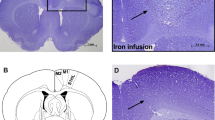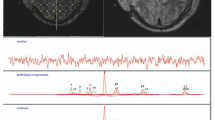Abstract
Traumatic brain injury (TBI) results in an acute altered metabolic profile of brain tissue which resolves within hours of initial insult and yet some of the functional deficits and cellular perturbations persist for days. It is hypothesized that a delayed change in energy status does occur and is a factor in the neural tissue's ability to survive and regain function. Regional metabolic profile and glucose consumption were determined at either 1 or 3 days following two different intensities of parasagittal fluid-percussion (F-P). A significant decrease in both 1CMRgluc and levels of ATP and P-creatine was evident in the hemisphere ipsilateral to the trauma at 1 day after the insult. The effect was greater in the cortical than the subcortical regions and was more pronounced at the higher trauma intensity. Normalization of glucose consumption and energy levels was essentially complete by 3 days. It would appear that the delayed metabolic changes at 1 day postinsult cannot be explained by a secondary ischemia since the changes in the metabolite profile do not elicit an increase in the consumption of glucose. These changes in energy metabolites may account for and contribute to the chronic neurological deficits following TBI.
Similar content being viewed by others
REFERENCES
Andersen, B., and Marmarou, A. (1992). Post traumatic selective stimulation of glycolysis. Brain Res. 585:184-189.
Beer, R., Franz, G., Krajewski, S., Pike, B.R., Hayes, R.L., Reed, J.C., Wang, K.K., Klimmer, C., Schmutzhard, E., Poewe, W., and Kampfl, A. (2001). Temporal and spatial profile of caspase 8 expression and proteolysis after experimental traumatic brain injury. J. Neurochem. 78:862-873.
Bergsneider, M., Hovda, D.A., Shalmon, E., Kelly, D.F., Vespa, P.M., Martin, N.A., Phelps, M.E., McArthur, D.L., Caron, M.J., Kraus, J.F., and Becker, D.P. (1997). Cerebral hyperglycolysis following severe traumatic brain injury in humans: A positron emission tomography study. J. Neurosurg. 86:241-251.
Buczek, M., Ratcheson, R.A., Lust, W.D., McHugh, M., and Pappius, H.M. (1991). Effects of focal cortical freezing lesion on regional energy metabolism. J. Cereb. Blood Flow Metab. 11:845-851.
Demediuk, P., Faden, A.I., Romhanyi, R., Vink, R., and McIntosh, T.K. (1988). Traumatic brain injury in the rat: Effects on lipid metabolism, tissue magnesium, and water content. J. Neurotrauma 5:105-119.
DeSalles, A., Muizelaar, J., and Young, H. (1987). Hyperglycemia, cerebrospinal fluid lactic acidosis, and cerebral blood flow in severely head-injured patients. Neurosurgery 21:45-51.
Dixon, C., Lyeth, B., Pavlishock, J., Fidling, R.L., Hamm, R.J., Marmarou, A., Young, H.F., and Hayes, R.L. (1987). A fluid percussion model of experimental brain injury in the rat. J. Neurosurg. 67:110-119.
Faden, A., Demediuk, P., Panter, S., and Vink, R. (1989). The role of excitatory amino acids and NMDA receptors in traumatic brain injury. Science 244:798-800.
Feuerstein, G., Wang, X., and Barone, F. (1998). The role of cytokines in the neuropathology of stroke and neurotrauma. Neuroimmunomodulation 5:143-159.
Fineman, I., Hovda, D.A., Smith, M., Yoshino, A., and Becker, D.P. (1993). Concussive brain injury is associated with a prolonged accumulation of calcium: A 45Ca autoradiographic study. Brain Res. 624:94-102.
Folbergrova, J., Zhao, Q., and Katsura, K. (1995). N-tert-Butyl-a-phenylnitrone improves recovery of brain energy state in rats following transient focal ischemia. Proc. Natl. Acad. Sci. USA 92:5057-5061.
Ginsberg, M., Reivich, M., Giandomenico, A., and Greenberg, J. (1977). Local glucose utilization in acute focal cerebral ischemia: Local dysmetabolism and diaschisis. Neurology 27:1042-1048.
Ginsberg, M.D., Zhao, W., Alonso, O.F., Loor-Estades, J.Y., Dietrich, W.D., and Busto, R. (1997). Uncoupling of local cerebral glucose metabolism and blood flow after acute fluidpercussion injury in rats. Am. J. Physiol. 272:H2859-H2868.
Harris, L.K., Black, R.T., Golden, K.M., Reeves, T.M., Povlishock, J.T., and Phillips, L.L. (2001). Traumatic brain injury-induced changes in gene expression and functional activity of mitochondrial cytochrome C oxidase. J. Neurotrauma 18:993-1009.
Hill-Felberg, S.J., McIntosh, T.K., Oliver, D.L., Raghupathi, R., and Barbarese, E. (1999). Concurrent loss and proliferation of astrocytes following lateral fluid percussion brain injury in the adult rat. J. Neurosci. Res. 57:271-279.
Hovda, D.A., Lee, S.M., Smith, M.L., Von Stuck, S., Bergsneider, M., Kelly, D</del>., Shalmon, E., Martin, N., Caron, M., and Mazziotta, J. (1995). The neurochemical and metabolic cascade following brain injury: Moving from animal models to man. J. Neurotrauma 12:903-906.
Hovda, D.A., Yoshino, A., Kawamata, T., Katayama, Y., and Becker, D.P. (1991). Diffuse prolonged depression of cerebral oxidative metabolism following concussive brain injury in the rat: A cytochrome oxidase histochemistry study. Brain Res. 567:1-10.
Ikeda, Y., and Long, M. (1990). The molecular basis of brain injury and brain edema: The role of oxygen free radicals. Neurosurgery 27:1-11.
Jenkins, L.W., Moszynski, K., Lyeth, B.G., Lewelt, W., DeWitt, D.S., Allen, A., Dixon, C.E., Povlishock, J.T., Majewski, T.J., and Clifton, G.L. (1989). Increased vulnerability of the mildly traumatized rat brain to cerebral ischemia: The use of controlled secondary ischemia as a research tool to identify common or different mechanisms contributing to mechanical and ischemic brain injury. Brain Res. 477:211-224.
Kontos, H., and Wei, E. (1986). Superoxide production in experimental brain injury. J. Neurosurg. 64:803-807.
Lowry, O., and Passonneau, J. (1972). A Flexible System of Enzymatic Analysis, Academic Press, New York.
Lust,W.D., Feussner, G.K., Barbehenn, E.K., and Passonneau, J.V. (1981). The enzymatic measurement of adenine nucleotides and P-creatine in picomole amounts. Anal. Biochem. 110:258-266.
Lust, W.D., Taylor, C., Pundik, S., Selman, W., and Ratcheson, R. (in press). Ischemic cell death: Dynamics of delayed secondary energy failure during reperfusion following focal ischemia. Metab. Brain Dis.
Marmarou, A., Holdaway, R., Ward, J.D., Yoshida, K., Choi, S.C., Muizelaar, J.P., and Young, H.F. (1993). Traumatic brain tissue acidosis: Experimental and clinical studies. Acta Neurochir. Suppl. (Wien.) 57:160-164.
McIntosh, T.K. (1994). Neurochemical sequelae of traumatic brain injury: Therapeutic implications. Cerebrovasc. Brain Metab. Rev. 6:109-162.
McIntosh, T.K. (1992). Pharmacologic strategies in the treatment of experimental brain injury. J. Neurotrauma. 9(Suppl. I): 201-209.
McIntosh, T., Faden, A., Bendall, M., and Vink, R. (1987). Traumatic brain injury in the rat: Alterations in Brain Lactate and pH as characterized by H-1 and P-31 nuclear magnetic resonance. J. Neurochem. 49:1530-1540.
McIntosh, T.K., Vink, R., Noble, L., Yamakami, I., Fernyak, S., Soares, H., and Faden, A.L. (1989). Traumatic brain injury in the rat: Characterization of a lateral fluid-percussion model. Neuroscience 28:233-244.
Morganti-Kossmann, M.C., Rancan, M., Otto, V.I., Stahel, P.F., and Kossmann, T. (2001). Role of cerebral inflammation after traumatic brain injury: A revisited concept. Shock 16:165-177.
Nawashiro, H., Shima, K., and Chigasaki, H. (1995). Immediate cerebrovascular responses to closed head injury in the rat. J. Neurotrauma 12:189-197.
Pappius, H. (1981). Local cerebral glucose utilization in thermally traumatized rat brain. Ann. Neurol. 9:484-491.
Pierce, J.E., Smith, D.H., Trojanowski, J.Q., and McIntosh, T.K. (1998). Enduring cognitive, neurobehavioral and histopathological changes persist for up to one year following severe experimental brain injury in rats. Neuroscience 87:359-369.
Ponten, U., Ratcheson, R., Salford, L., and Siesjo, B. (1973). Optimal freezing conditions for cerebral metabolites in rats. J. Neurochem. 21:1121-1126.
Renuka Prasad, M., Ramaiah, C., and McIntosh, T. (1994). Regional levels of lactate and norepinephrine after experimental brain injury. J. Neurochem. 63:1094.
Robertson, C., Grossman, R., Goodman, J., and Narayan, R. (1987). The predictive value of cerebral anaerobic metabolism with cerebral infarction after head injury. J. Neurosurg. 67:361-368.
Shapira, Y., Setton, D., Artru, A., and Sholhami, E. (1993). Blood brain barrier permeability, cerebral edema, and neurologic function after closed head injury in rats. Anesth. Analg. 77:141-148.
Siesjö, B. (1993). Basic mechanisms of traumatic brain damage. Ann. Emerg. Med. 22:959-969.
Siesjo, B.K., Elmer, E., Janelidze, S., Keep, M., Kristian, T., Ouyang, Y.B., and Uchino, H. (1999). Role and mechanisms of secondary mitochondrial failure. Acta Neurochir. Suppl. (Wien.) 73:7-13.
Siesjö, B., and Siesjö, P. (1996). Mechanisms of secondary brain damage. Anaesthesiology 13:247-268.
Soares, H., Thomas, M., Cloherty, K., and McIntosh, T. (1992). Development of prolonged focal cerebral edema and regional cation changes following experiment brain injury in rat. J. Neurochem. 58:1845-1852.
Sokoloff, L., Reivich, M., Kennedy, C., Des Rosiers, M.H., Patlak, C.S., Pettigrew, K.D., Sakurada, O., and Shinohara, M. (1977). The [14C]deoxyglucose method for the measurement of local cerebral glucose utilization: Theory, procedure, and normal values in the conscious and anesthetized albino rat. J. Neurochem. 28:897-916.
Trivedi, B., and Danforth, W. (1966). Effect of pH on the kinetics of frog muscle phosphofructokinase. J. Biol. Chem. 241:4110-4112.
Vink, R., Faden, A., and McIntosh, T. (1987a). Changes in cellular bioenergetic state following graded traumatic brain injury in rats: Determination by phosphorus 31 magnetic resonance spectroscopy. J. Neurotrauma 5:315-329.
Vink, R., McIntosh, T.K., Weiner, M.W., and Faden, A.I. (1987b). Effects of traumatic brain injury on cerebral high-energy phosphates and pH: A 31P magnetic resonance spectroscopy study. J. Cereb. Blood Flow Metab. 7:563-571.
Yamakami, I., and McIntosh, T. (1991). Alterations in regional cerebral blood flow following brain injury in the rat. J. Cereb. Blood Flow Metab. 11:655-660.
Yoshino, A., Hovda, D.A., Kawamata, T., Katayama, Y., and Becker, D.P. (1991). Dynamic changes in local cerebral glucose utilization following cerebral conclusion in rats: Evidence of a hyper-and subsequent hypometabolic state. Brain Res. 561:106-119.
Rights and permissions
About this article
Cite this article
Buczek, M., Alvarez, J., Azhar, J. et al. Delayed Changes in Regional Brain Energy Metabolism following Cerebral Concussion in Rats. Metab Brain Dis 17, 153–167 (2002). https://doi.org/10.1023/A:1019973921217
Issue Date:
DOI: https://doi.org/10.1023/A:1019973921217




